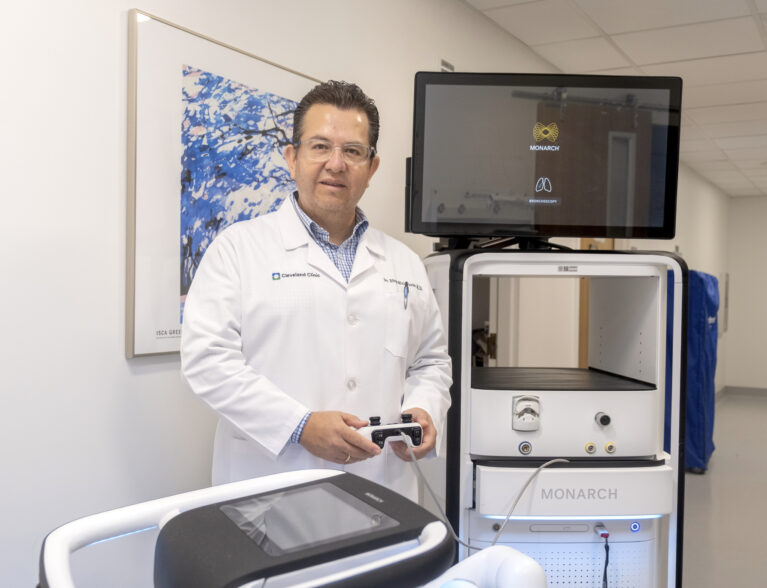
As with many diseases, early diagnosis and treatment of lung cancer greatly increases patient survival rate, and new techniques and technologies are making early diagnosis more common, improving patient care and outcomes.
Such is the case with robotic bronchoscopy, a groundbreaking advancement that has revolutionized the way respiratory and pulmonary conditions are diagnosed and treated, with the aim of stopping tumors from developing into cancer.
“Bronchoscopy is a tool that pulmonologists utilize for the diagnosis of multiple pulmonary conditions,” said Dr. Diego Maldonado, a pulmonologist with Cleveland Clinic Indian River Hospital. “It’s basically like an endoscopy – a little cylindrical hose with a camera on the tip of it and some channels that go through the hose that lets us travel through the bronchial tubes. Most of the time we introduce the bronchoscope through the mouth and then through the vocal cords and then through the trachea and into the bronchial tubes.
“Forty or 50 years ago, bronchoscopy was just utilized for minor procedures such as culturing the lungs from infections and just to visualize and examine the inside of your bronchial tubes. But as science has progressed and the prevalence of lung cancer increased, technology started advancing towards a diagnostic approach of bronchoscopy. We are now utilizing bronchoscopy to actually reach those little lung spots or lung nodules,” to determine if they are cancerous.
The new use of bronchoscopy first enabled surgeons to access and biopsy larger lung nodules, with small instruments passed through the scopes, but smaller nodules measuring only a centimeter or two were nearly impossible to reach. Through several evolutions, the technology advanced to electromagnetic bronchoscopy which utilizes and electromagnetic field and advanced imaging of the chest to create a map like a GPS system that guides the surgeon through the bronchial tubes and little branches to the exact location of the small nodules. This procedure increased the accuracy and diagnosis to about 50 percent to 70 percent. Because the lungs are constantly moving with each breath, it was still a struggle to get accurate biopsies and diagnosis.
Within the last few years robotic bronchoscopy has elevated the odds of getting an accurate diagnosis of small nodules in the peripheral lungs to more than 90 percent by utilizing a robotic system with specialized instruments to navigate deep into the lungs, reaching areas that were previously very difficult to access. The new systems are equipped with high-definition cameras and real-time image processing that allow accurate visualization of the airways with the potential to perform diagnostic biopsies with great precision.
“The robotic platform gives us more control,” Dr. Maldonado explained. “Basically, we hold a controller in our hands and the robot drives the bronchoscope through the airway, avoiding any unnecessary movement of the human hand.
“We utilize the electromagnetic navigation system to travel through the bronchial tubes and guide us through the mapping and once we reach the nodule, we can lock the bronchoscope so it stays fixed and stable.
“Once at the target, we can adjust the bronchoscope tip with precise, sub-millimeter movements using the controller. The bronchoscope provides stability, maintaining the scope tip position during the biopsy. Prior to this technology open lung surgery would have been necessary to reach [the same] diagnosis.”
More than 6 percent of men and women will be diagnosed with lung and bronchus cancer at some point in their lifetime according to the National Cancer Institute. In 2023, there were approximately 238,340 new cases of lung cancer resulting in about 127,070 deaths.
Utilizing the robotic bronchoscopy technology for early detection and treatment will play a vital role in increasing survival rates and saving people who might otherwise die.
“The majority of the lung nodules are benign and this robotic procedure prevents the patient from having unnecessary surgery just to get the diagnosis,” Dr. Maldonado said.
“We now have a great, nonsurgical way to diagnose these peripheral nodules for early detection of lung cancer. We are changing history by trying to decrease the long-term mortality of this cancer by catching it earlier. At the same time, we are also preventing unnecessary procedures.”
Lung cancer screenings with a low dose CT scan are the most common way to identify a lung nodule. If a lung nodule is detected and it’s larger than 0.6 centimeters, then your physician may recommend that you undergo diagnostic procedures to see if you have early-stage lung cancer.
“The robotic bronchoscopy is a safe, outpatient procedure done under general anesthesia and most patients go home the same day,” Dr. Maldonado said. “With the robotic bronchoscopy that diagnosis can be made early on when the nodule is miniscule. The smaller the tumor is when diagnosed and treated, the better the prognosis the patient has for a five-year survival.”
While robotic bronchoscopy is currently used for diagnostic purposes, the technology’s future role may be in early treatment, such as bronchoscopic tumor ablation – applying precise doses of radiofrequency energy, heat, cold or radiation to destroy a lung tumor from inside the body, without the need for incisions. Robotic-assisted bronchoscopy continues to evolve, offering patients a safe, streamlined, timely diagnosis and earlier, more effective treatment.
Dr. Diego Maldonado is originally from Ecuador, where he earned his medical degree at Universidad Central del Ecuador. He moved to Miami to complete his Internal Medicine residency training, followed by a fellowship in Critical Care and Pulmonary Medicine at the University of Miami-Jackson Memorial Hospital. He diagnoses and treats pulmonary conditions such as asthma, emphysema, COPD, pulmonary hypertension, sarcoidosis, sleep apnea – and lung cancer. He has been at Cleveland Clinic Indian River Hospital for 13 years. His office is located in the Rosner Family Health and Wellness Center, 3450 11th Court, Vero Beach: 772-794-5800.



